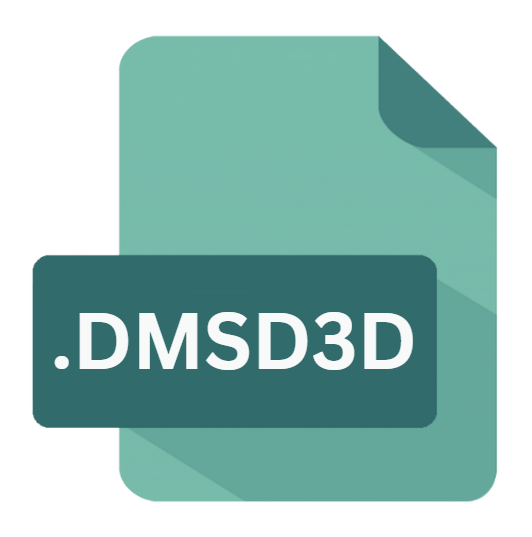.DMSD3D File Extension

Roxio MyDVD 3D Project
| Developer | Sonic Solutions |
| Popularity | |
| Category | Video Files |
| Format | .DMSD3D |
| Cross Platform | Update Soon |
What is an DMSD3D file?
The .DMSD3D file extension is associated with Roxio MyDVD, a multimedia software suite primarily used for creating, editing, and burning DVDs and Blu-rays.
Specifically, the .DMSD3D file represents a 3D project file within MyDVD, designed to manage 3D video editing projects.
This file contains the information and configurations necessary to assemble and render a 3D video project, including references to media files, video effects, transitions, and other project settings.
More Information.
Roxio MyDVD has a long history as a leading software solution for DVD and Blu-ray creation.
Initially launched as a simple DVD authoring tool, the software evolved to include more advanced features such as video editing, menu creation, and, eventually, 3D video project support.
The introduction of the .DMSD3D file format was part of this evolution, allowing users to work with 3D content in a way that was previously only possible with professional-grade software.
The initial purpose of the .DMSD3D file was to encapsulate all the components of a 3D video project in a single file that could be easily saved, opened, and edited within the MyDVD software.
This file format enabled users to work with 3D videos, apply effects, transitions, and other enhancements, and then render the final project for burning to a 3D-capable DVD or Blu-ray.
Origin Of This File.
The .DMSD3D file extension originated as part of the Roxio MyDVD software suite, a product developed by Sonic Solutions, which later became a division of Corel Corporation.
The .DMSD3D file was introduced as a means to support the rising popularity of 3D media content, providing users with a way to edit and compile 3D video projects in a streamlined and accessible format.
The need for a specific 3D project file format arose from the growing interest in 3D technology during the late 2000s and early 2010s, driven by the success of 3D movies in theaters and the increasing availability of 3D-capable devices in homes.
Roxio MyDVD sought to provide consumers with the tools necessary to create and edit their 3D content, making the .DMSD3D file an essential part of the software’s functionality.
File Structure Technical Specification.
The .DMSD3D file is a project file, meaning it does not contain actual media content but rather references to the media files used in the project, along with project-specific settings and metadata. The structure of a .DMSD3D file typically includes the following components:
- Project Metadata: Information about the project, such as the project name, creation date, and last modified date.
- Media References: Paths to the video, audio, and image files used in the project. These references ensure that the correct media files are used when the project is opened.
- 3D Video Settings: Configuration settings specific to the 3D aspects of the project, such as stereoscopic 3D settings, 3D effects, and transitions.
- Editing Instructions: Details of the edits made to the project, including the timeline of video clips, applied effects, transitions, and any other modifications.
- Project Assets: References to any additional assets used in the project, such as background images, soundtracks, and menu templates.
The .DMSD3D file is typically encoded in a proprietary format, making it readable only by Roxio MyDVD or compatible software.
How to Convert the File?
Converting a .DMSD3D file directly into another format is not typically possible, as it is a project file rather than a media file.
You can export the contents of a .DMSD3D project to a different format using Roxio MyDVD. Here’s how:
- Open the .DMSD3D File: Launch Roxio MyDVD and open the .DMSD3D file you wish to convert.
- Edit the Project (Optional): Make any necessary adjustments to the project, such as trimming clips, adding effects, or modifying the 3D settings.
- Export the Project: Once the project is ready, use the “Export” or “Render” function in MyDVD to output the project as a 3D video file. Common export formats include .MP4, .AVI, and .MKV, which are compatible with most media players and devices.
- Burn to DVD/Blu-ray (Optional): If you intend to burn the project to a 3D-capable DVD or Blu-ray, follow the on-screen instructions within MyDVD to complete the process.
Advantages And Disadvantages.
Advantages:
- Streamlined 3D Project Management: The .DMSD3D file allows users to manage all aspects of a 3D video project in a single file, making it easy to save, share, and edit projects.
- Integration with Roxio MyDVD: As part of the Roxio MyDVD suite, the .DMSD3D file is fully compatible with the software’s features, allowing for seamless editing and rendering of 3D content.
- Support for Advanced 3D Features: The file format supports various 3D-specific settings, enabling users to create professional-quality 3D video projects without needing specialized software.
Disadvantages:
- Limited Compatibility: The .DMSD3D file format is proprietary and can only be opened and edited with Roxio MyDVD or compatible software. This limits its usability outside of the MyDVD ecosystem.
- Dependency on External Media Files: Since the .DMSD3D file only references media files rather than containing them, it is dependent on the availability of these external files. If the referenced files are moved or deleted, the project may become unusable.
- Potential for Obsolescence: As technology evolves, there is a risk that the .DMSD3D file format may become obsolete, especially if Roxio MyDVD is discontinued or no longer supports 3D projects.
How to Open DMSD3D?
Open In Windows
- Install Roxio MyDVD: Ensure that Roxio MyDVD is installed on your Windows PC.
- Open MyDVD: Launch the software.
- Load the .DMSD3D File: Use the “Open Project” option in MyDVD to browse for and select the .DMSD3D file.
- Edit and Render: Once the project is loaded, you can edit it as needed and render it into a final video format.
Open In Linux
- Roxio MyDVD is also not supported on Linux. Similar to macOS, you can use a Windows virtual machine or Wine (a compatibility layer for running Windows applications on Linux) to run MyDVD. However, compatibility is not guaranteed, and performance may vary.
Open In MAC
- Unfortunately, Roxio MyDVD is not natively supported on macOS. However, you can use a Windows virtual machine (such as Parallels Desktop or VMware Fusion) to run Roxio MyDVD on a Mac. The steps to open a .DMSD3D file would then be the same as for a Windows system.












